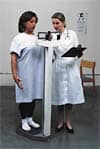Sleep technology requires its own specialized training programs.
 There has been a tremendous increase in demand for sleep medicine patient care services over the past several years, driven by the heightened appreciation of sleep disorders in the general population, the increase in scientific research into sleep and sleep disorders, and improved education of health care providers. This has culminated in the recent recognition of sleep medicine as a formal medical specialty. Due to the rapid increase in the number of sleep centers and laboratories, there is now high demand for qualified sleep technologists to provide critical diagnostic and therapeutic services. Further growth is dependent on continued scientific advances and the availability of well-trained and competent sleep technologists.
There has been a tremendous increase in demand for sleep medicine patient care services over the past several years, driven by the heightened appreciation of sleep disorders in the general population, the increase in scientific research into sleep and sleep disorders, and improved education of health care providers. This has culminated in the recent recognition of sleep medicine as a formal medical specialty. Due to the rapid increase in the number of sleep centers and laboratories, there is now high demand for qualified sleep technologists to provide critical diagnostic and therapeutic services. Further growth is dependent on continued scientific advances and the availability of well-trained and competent sleep technologists.
 Lawrence J. Epstein, MD
Lawrence J. Epstein, MD
Meeting this need requires the sleep technology field to follow a path similar to that followed by sleep medicine, with the goal to be formal recognition as an independent allied health profession. Sleep technology has its roots in several disciplines but now encompasses a knowledge base and skill set that requires specialized training above that available in the original fields. To be recognized as an independent profession, sleep technology must take steps to standardize its training and ensure the quality of its practitioners. The American Academy of Sleep Medicine (AASM) is supporting several efforts to achieve this goal. Chief among these efforts is education; the AASM recognizes that a profession of sleep technology requires standardized education and demonstration of competency.
The ultimate goal is formal college-based education in sleep technology. This requires establishment of accredited sleep technology training programs. AASM is a full partner in the Committee on Accreditation for Polysomnographic Technologist Education (CoA PSG), which includes the Association of Polysomnographic Technologists, the Board of Registered Polysomnographic Technologists (BRPT), and the AASM, and is approved by the Commission on Accreditation of Allied Health Education Programs (CAAHEP). The CoA PSG will accredit training programs that meet rigorous standards and provide comprehensive education in sleep technology leading to eligibility for the BRPT examination. The CoA PSG is now accepting applications. Standards and application forms can be downloaded from the CAAHEP Web site at www.caahep.org. Click on the Committees on Accreditation heading and then on Polysomnographic Technologists.
While this is a positive step forward, it will be many years before such programs can fully meet the needs of the field. In order to avoid a shortage that hinders development of the field, there must be a more immediate effort to standardize education and improve skills. The AASM has established a new committee, the Polysomnographic Technologist Issues Committee, to spearhead our educational efforts. The committee consists of educators, clinicians, and technologists. It has been charged with the development of a comprehensive practical experience track that includes standardized education and formal training programs designed to occur in a clinical setting. The three parts are an intensive didactic education course, followed by additional computer-based learning, followed by demonstration of competency through passage of the BRPT examination. An overview of the first part of this track is introduced below; details of the second part of this track will be posted on the AASM Web site as they become available.
The first component of this track is a didactic 80-hour course that provides in-depth instruction in basic and clinical sciences related to sleep, as well as the fundamentals of sleep technology. After completion of this course, the individuals must pass a competency examination to be recognized as a Polysomnographic Technology Trainee. With this designation, the trainee can begin the second component of this track under the supervision of other technologists and technicians.
The Polysomnographic Technologist Issues Committee has developed and adopted standards for accreditation of these didactic courses that define the minimum requirements in specific areas, such as personnel, resources, curriculum, assessment, admission, and fair practice. The committee is working on a sample syllabus and educational materials. A standardized examination will be provided for graduates of the intensive training programs. The AASM anticipates that there will be two kinds of programs seeking this accreditation: schools of sleep technology that serve as a regional resource and larger sleep disorders centers that utilize the course to train replacement help or keep up with expansion.
To review the Standards for Accreditation of Intensive Educational Programs in Sleep Technology, visit the online news section of the AASM Web site at www.aasmnet.org. Also available on the Web site is the Application for Accreditation of Intensive Educational Programs in Sleep Technology. The AASM is now accepting applications for accreditation of intensive programs.
I encourage all accredited member centers and schools interested in training technologists to review the standards and apply for AASM accreditation of their educational and training programs. These programs are critical to ensuring an adequate supply of well-trained technologists to meet current and expected needs of our centers, and to aid sleep technology in becoming a formally recognized field.
Lawrence J. Epstein, MD, is president of the American Academy of Sleep Medicine (AASM), Westchester, Ill. Questions and requests for more information about the AASM’s educational and training programs should be directed to Richard Rosenberg, PhD, at [email protected] or (708) 492-0930.



